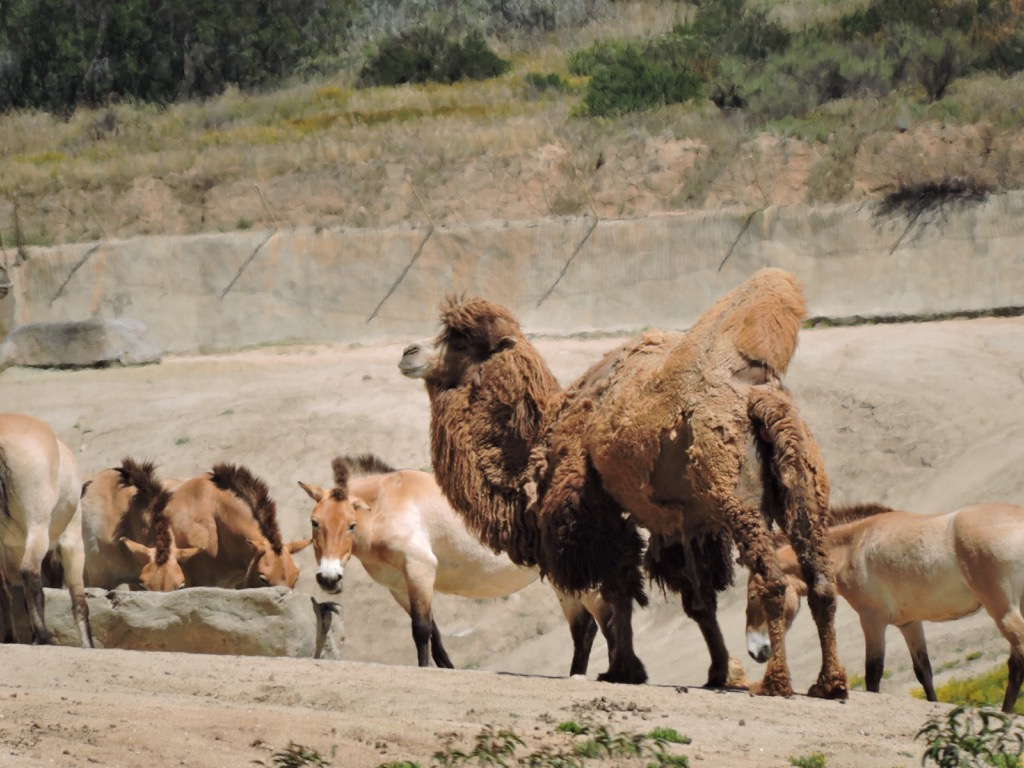 A big part of understanding paleontology is to understand the way things work today. In interpreting fossils, paleontologists first look to the modern world for analogs, whether it's identifying a species, interpreting behavior and ecological relationships, or even understanding how a fossil came to be preserved at all – the subbranch of paleontology known as taphonomy.A few weeks ago Brett and I were visiting the San Diego Zoo's Safari Park, located in Escondido about 45 minutes from the museum. While photographing Przewalski's horses and Bactrian camels (above, both of which have Pleistocene relatives preserved at Diamond Valley Lake), Brett noticed an odd shape located on a hillside in the exhibit (inside the red circle below):
A big part of understanding paleontology is to understand the way things work today. In interpreting fossils, paleontologists first look to the modern world for analogs, whether it's identifying a species, interpreting behavior and ecological relationships, or even understanding how a fossil came to be preserved at all – the subbranch of paleontology known as taphonomy.A few weeks ago Brett and I were visiting the San Diego Zoo's Safari Park, located in Escondido about 45 minutes from the museum. While photographing Przewalski's horses and Bactrian camels (above, both of which have Pleistocene relatives preserved at Diamond Valley Lake), Brett noticed an odd shape located on a hillside in the exhibit (inside the red circle below):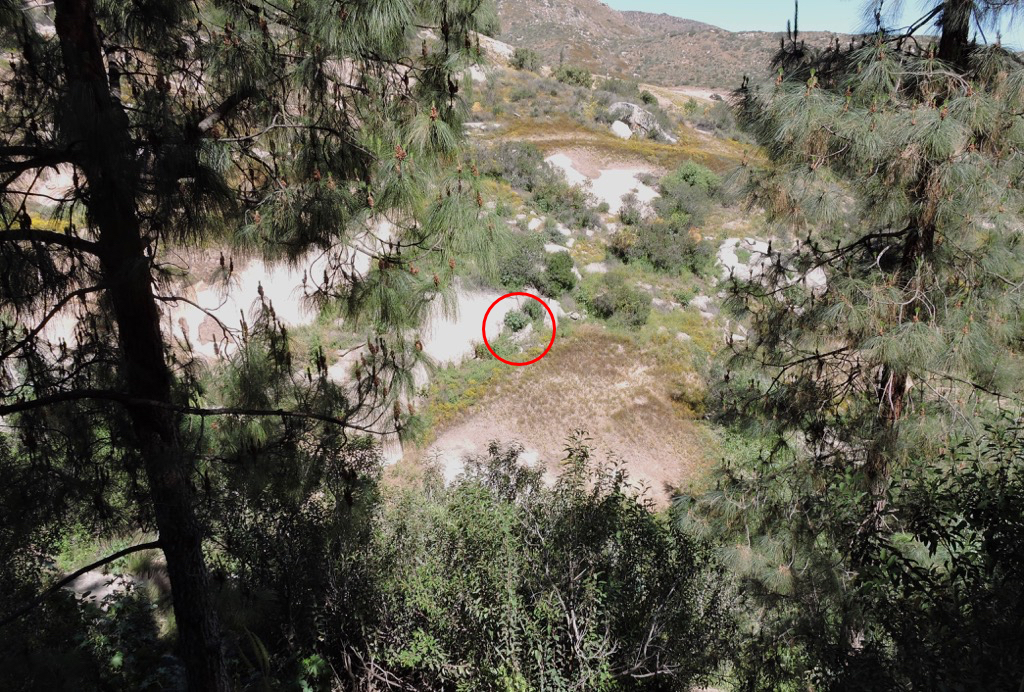 Fortunately I have a camera with a pretty powerful zoom lens, so I was able to get a closeup look at the area:
Fortunately I have a camera with a pretty powerful zoom lens, so I was able to get a closeup look at the area: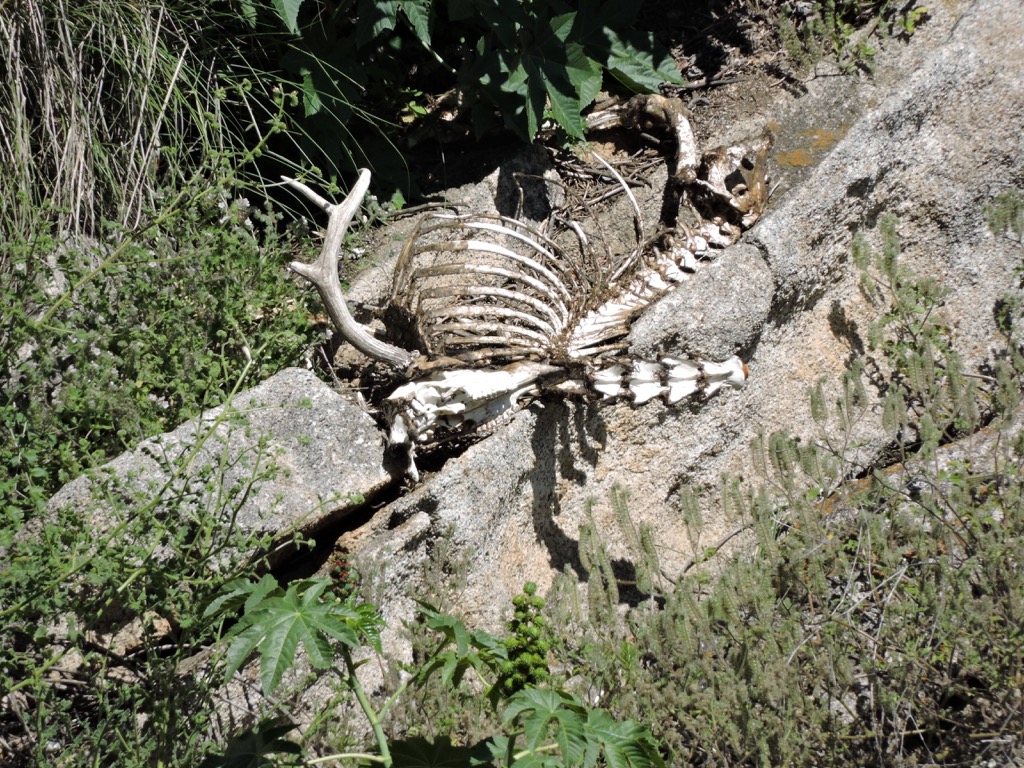 A skeleton! There's enough here to make an attempt at some identifications:
A skeleton! There's enough here to make an attempt at some identifications: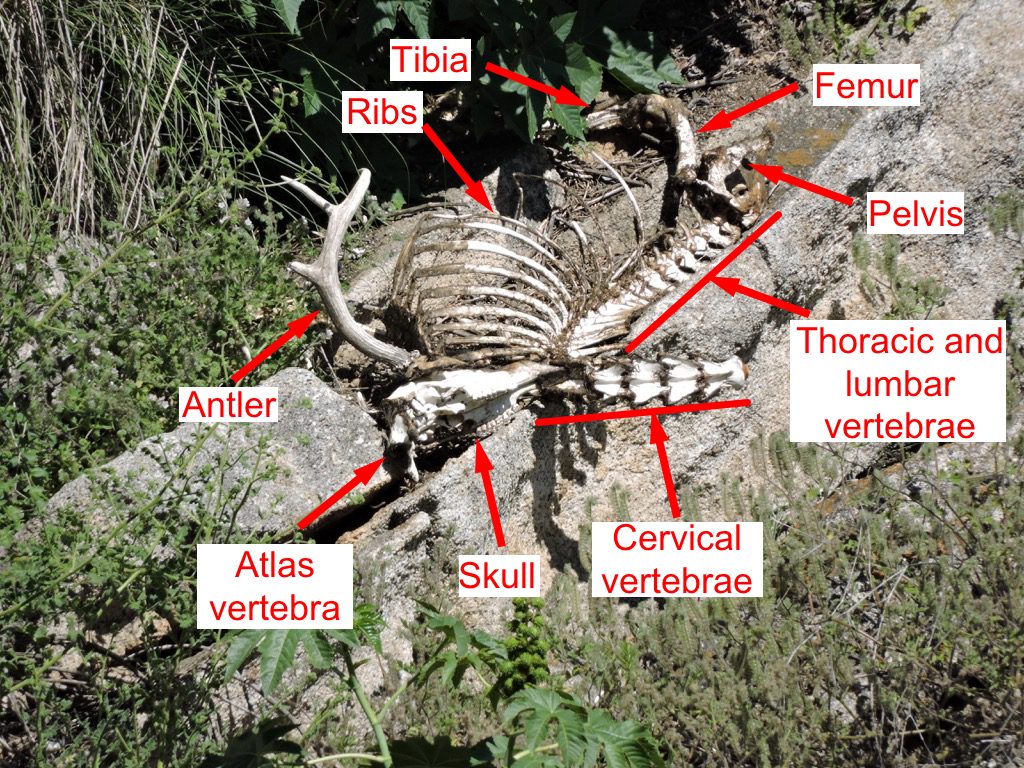 Quite a lot of this skeleton is present, and we can say a fair amount about it. First, the presence of an antler is significant. We can tell it's an antler and not a horn from the multiple tines (at least three), and because it has a growth pedicle. That puts this in the Cervidae, the deer family. Unless it's an exotic animal from the zoo collection or some other source (unlikely) that means a mule deer, Odocoileus hemionus.The skeleton is mostly intact and articulated, and there are still a few bits and pieces of skin and fur attached in places. The neck has bent backwards, a common occurrence after death. As the carcass dries out, the nuchal ligament that runs along the back of the neck tends to shorten, pulling the head backwards over the back.There has been some disturbance to the skeleton. The head has been pulled off the body. With the attached atlas vertebra, it has been flipped upside down (relative to the body) and rotated 180 degrees so that the snout is facing the back. The lower jaw is missing entirely. The lower parts of the hind limbs are probably obscured by vegetation, but the front limbs including the shoulder blades are missing. With the skeleton sitting on a steep hillside, we wondered if some the bones had ended up downhill, and we spent a half hour or so with the camera examining the hillside, with some success. About 10-20 m down the hill we located an ulna:
Quite a lot of this skeleton is present, and we can say a fair amount about it. First, the presence of an antler is significant. We can tell it's an antler and not a horn from the multiple tines (at least three), and because it has a growth pedicle. That puts this in the Cervidae, the deer family. Unless it's an exotic animal from the zoo collection or some other source (unlikely) that means a mule deer, Odocoileus hemionus.The skeleton is mostly intact and articulated, and there are still a few bits and pieces of skin and fur attached in places. The neck has bent backwards, a common occurrence after death. As the carcass dries out, the nuchal ligament that runs along the back of the neck tends to shorten, pulling the head backwards over the back.There has been some disturbance to the skeleton. The head has been pulled off the body. With the attached atlas vertebra, it has been flipped upside down (relative to the body) and rotated 180 degrees so that the snout is facing the back. The lower jaw is missing entirely. The lower parts of the hind limbs are probably obscured by vegetation, but the front limbs including the shoulder blades are missing. With the skeleton sitting on a steep hillside, we wondered if some the bones had ended up downhill, and we spent a half hour or so with the camera examining the hillside, with some success. About 10-20 m down the hill we located an ulna: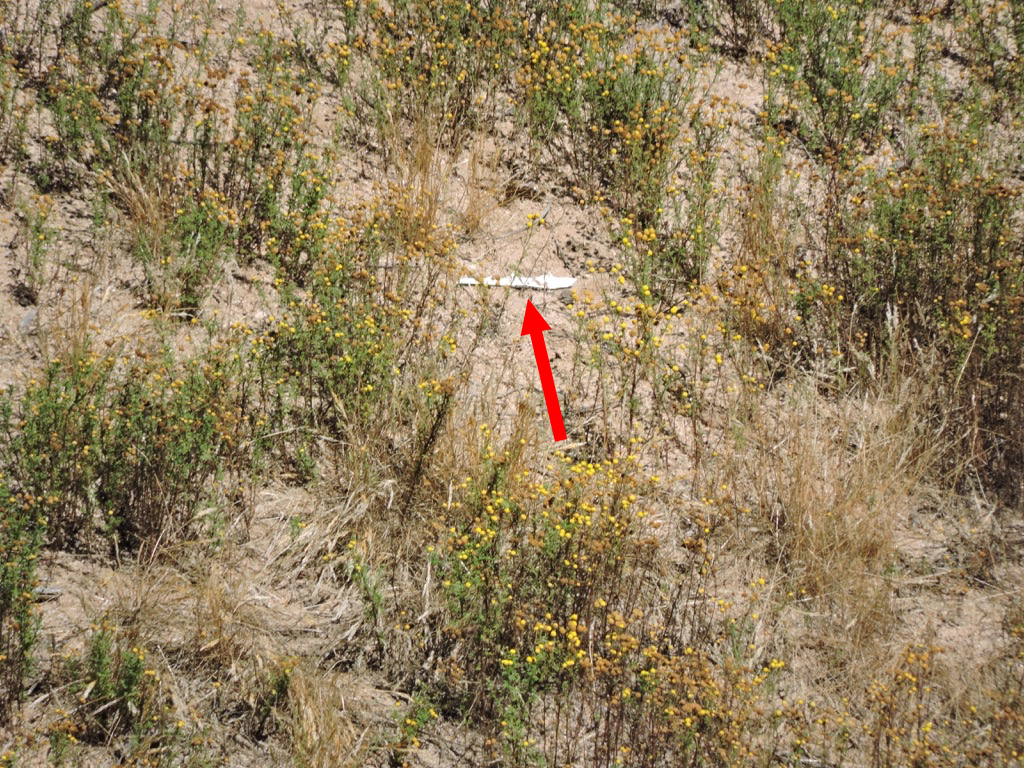 ... a partial scapula:
... a partial scapula: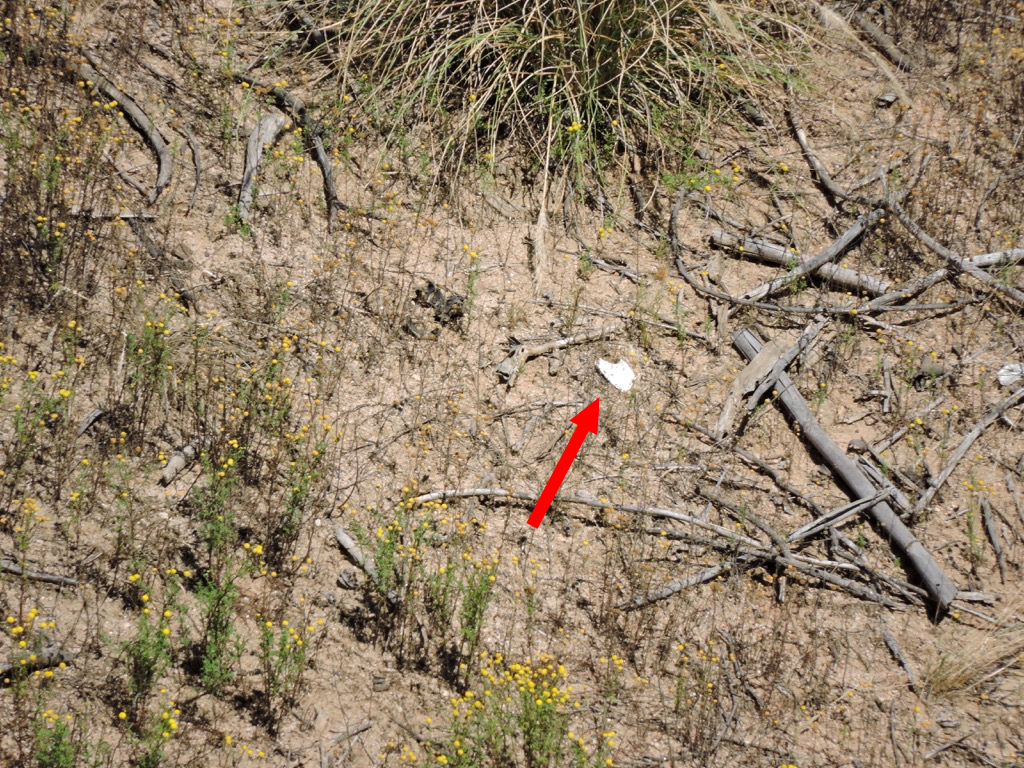 ...and a humerus:
...and a humerus: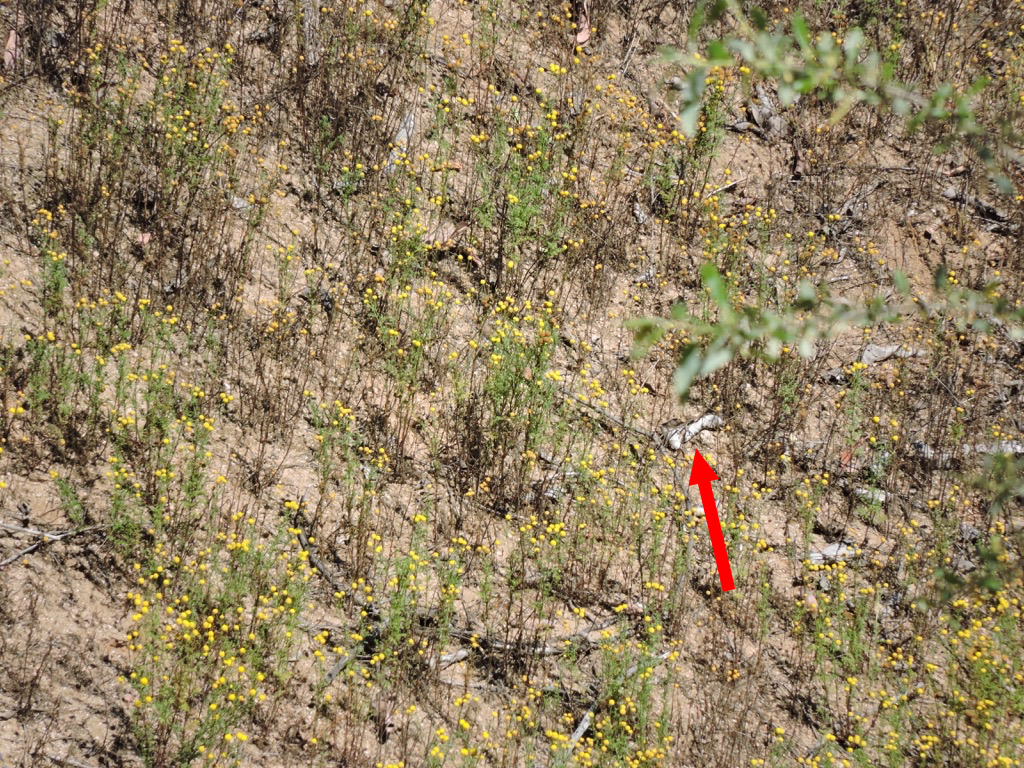 We never did find the lower jaw.So, what's the story of this skeleton? I'm not sure why the deer was in the enclosure in the first place, but there are steep cliffs in the area; I suppose it's possible the deer could have fallen in, and maybe even been killed in the fall. There was some disturbance of the carcass after death, but probably not by really large scavengers. I assume zoo staff would have removed the carcass or left it alone entirely, so they probably aren't responsible for the disturbance. I also think it's unlikely that large carnivorans such as coyotes, black bears, and mountain lions are allowed to roam freely with the zoo's herbivores, and they likely would have torn up the skeleton more than what we see. Small carnivores are a different matter. On the same trip we saw squirrels passing back and forth through small openings in some of the fences; a feral cat could have passed through the same openings. For that matter, squirrels and other rodents will also scavenge carcasses, mostly looking for calcium in the bones. But the most likely culprits are scavenging birds such as ravens, crows, and turkey vultures. These birds are large enough to strip a carcass and even remove some pieces (like the skull and the front legs), but often leave large parts of the skeleton intact, and, of course, they have no difficulty in gaining access to the enclosure.Since this skeleton is in a zoo, it's somewhat protected from the full range of taphonomic processes it would be exposed to in the wild, such as large mammalian scavengers, but that alone isn't enough to save it. Over time, the skeleton will break down in the sun. The outer cortical bone will deteriorate and flake away, and once the interior bone is exposed the breakdown will occur even faster. Occasional rainstorms will speed this process, as will insects and rodents feeding on the bone itself. More robust fragments, such as the ends of limb bones and flakes of tooth enamel may survive a bit longer and wash down the hill. There is a small stream at the bottom of the hill, so it's conceivable (if unlikely) that a few of these more robust fragments could be buried in stream sediments. Within a few years, if anything of this deer survives, that will probably be all there is.
We never did find the lower jaw.So, what's the story of this skeleton? I'm not sure why the deer was in the enclosure in the first place, but there are steep cliffs in the area; I suppose it's possible the deer could have fallen in, and maybe even been killed in the fall. There was some disturbance of the carcass after death, but probably not by really large scavengers. I assume zoo staff would have removed the carcass or left it alone entirely, so they probably aren't responsible for the disturbance. I also think it's unlikely that large carnivorans such as coyotes, black bears, and mountain lions are allowed to roam freely with the zoo's herbivores, and they likely would have torn up the skeleton more than what we see. Small carnivores are a different matter. On the same trip we saw squirrels passing back and forth through small openings in some of the fences; a feral cat could have passed through the same openings. For that matter, squirrels and other rodents will also scavenge carcasses, mostly looking for calcium in the bones. But the most likely culprits are scavenging birds such as ravens, crows, and turkey vultures. These birds are large enough to strip a carcass and even remove some pieces (like the skull and the front legs), but often leave large parts of the skeleton intact, and, of course, they have no difficulty in gaining access to the enclosure.Since this skeleton is in a zoo, it's somewhat protected from the full range of taphonomic processes it would be exposed to in the wild, such as large mammalian scavengers, but that alone isn't enough to save it. Over time, the skeleton will break down in the sun. The outer cortical bone will deteriorate and flake away, and once the interior bone is exposed the breakdown will occur even faster. Occasional rainstorms will speed this process, as will insects and rodents feeding on the bone itself. More robust fragments, such as the ends of limb bones and flakes of tooth enamel may survive a bit longer and wash down the hill. There is a small stream at the bottom of the hill, so it's conceivable (if unlikely) that a few of these more robust fragments could be buried in stream sediments. Within a few years, if anything of this deer survives, that will probably be all there is.
